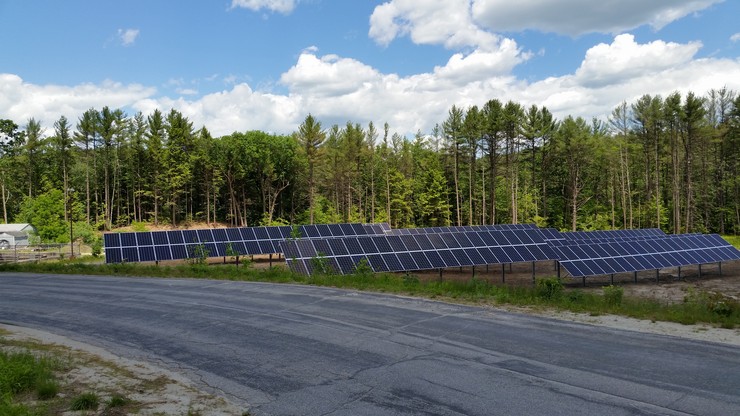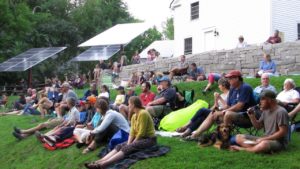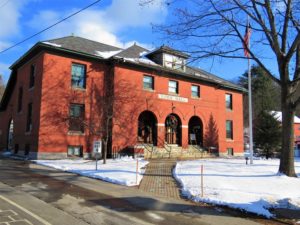News of a Groundbreaking Design for a Community Microgrid
By George Harvey
Warner, New Hampshire, has not yet built its microgrid. It has not yet installed any of its hardware. In fact, it has not even identified where its first installations will go. Nevertheless, some people (including me) consider its story stunningly exciting.
To look at it, Warner it is not a place that a person might expect to stand out as an example of leading edge ingenuity. It seems too small and rural to answer that description. Its total population is about 2,835 people. Its buildings are spread out, and in the 2010 census, only 444 people lived in the town center.
Nevertheless, the town has a long history with renewable energy, and we have seen movements toward sustainable energy in the past. Green Energy Times published an article in the December 2012 edition, “Local Solar-Powered Bookstore Happily Shares with the Community”(http://bit.ly/GET-solar-bookstore). A second article, “Summer Fun from the Sun,” which appeared in June of 2015, is about a solar-powered outdoor stage (http://bit.ly/GET-solar-stage). Both of these stories related to activities of Niel Nevens, who runs MainStreet BookEnds of Warner.
Now the town has a pair of newer solar arrays. One was a 114-kilowatt (kW) array on Water District land, completed in 2016. The other was of 113.4kW, built at the transfer station in 2017. The earlier reported array at Main Street Bookends has grown to over 20kW, but other solar systems are also being installed by people who are using net metering to reduce both their electric bills and their carbon footprints. In fact, most of the major building permits being issued in Warner are for solar systems.
This brings us to the “microgrid.” A community microgrid is an electric system that can provide power to the community when the main power grid fails. To build one means that the community has to have systems for generating power, storing it, and distributing it, possibly with secondary generation for redundant backup. The system might include a sufficiently large set of solar arrays with a large battery, probably distributing power over the same local transmission lines as the main grid, with a diesel generating plant for backup. The system would also include a set of switches to separate it from the main grid.
The thing that makes Warner’s design really exciting is that it addresses a number of questions relating to microgrid development. Some of these relate to how to build the microgrid’s physical system, including details of how to connect together the buildings on the microgrid. Others relate to the costs, including how the microgrid is paid for by customers. Still other questions have to do with community acceptance and what to do, for example, about a person whose home is physically within the microgrid’s area but does not want to participate.
The proposed design from the Warner project solves those issues very easily by taking a single novel approach. It virtualizes the microgrid. The overall microgrid is, in fact, a virtual power plant consisting of smaller, individual microgrids (for purposes of clarity, the smaller individual microgrids are here referred to as nanogrids). Each nanogrid draws power or contributes it, according to demand and under the guidance of a system of computers.
While that might sound like computer babble, the nuts and bolts of this approach are fairly easy to understand. Just as a microgrid can operate independently of the main electric grid, a microgrid can be subdivided into a set of smaller nanogrids, each capable of operating independently. In Warner’s microgrid, each building will be able to function on its own, generating its own power, and storing its own energy. Combining them together is essentially a bookkeeping problem under computer control, based on practices of the microgrid and the local utility.
One function of the microgrid is to organize the various nanogrids to communicate with each other. With organization, the microgrid provides an aggregated virtual power plant through which the nanogrids can communicate with the main utility grid.
One obvious advantage of such a system is its resilience. When the main grid goes down, those local nanogrids will continue to function. If they are connected together with transmission wires that are still functioning, they can support each other. If there are enough of them, they can support the rest of the community, including those people who decided not to participate in the system.
With resiliency built into a sufficiently large percentage of local homes and businesses, the community continues to function even in an extended outage. It might be well to think of the effect of this on the community’s attractiveness to, for example, a bank, a supermarket, or a pharmacy that is looking for a town to be a home to a branch or business. And this is especially true, given that more than one agency of the federal government has told us that we need to be prepared for grid outages lasting as long as three years due to such disparate threats as solar storms and terrorism.
Even if the grid never went down, the system offers a good deal of value. One of the functions it should perform is to buy and sell electricity at spot market rates. When the rates are low, the microgrid can buy power to charge batteries, even if the sun is not shining. When the rates are high, it can sell power at a profit.
From the point of view of the utility, such a system could offer very important advantages. When they do not have enough power to meet demand otherwise, utilities have to buy on the spot market, but they normally have to sell at fixed rates. When demand is high, the spot rates can be a multiple of the retail rates, and this means that the utility loses money on all the electricity it sells. With a virtual power plant offering another alternative, the utility can save a good deal of money.
For many utilities, transmission costs are partly based on their peak load for the previous year. A virtual power plant reduces that peak load, saving money for the utility, and all of its customers.

A 114-kW solar array for Warner, NH will help to keep the power on even if the grid goes down. Courtesy photo.
Warner’s microgrid has already received some important support. The Carsey Institute at the University of New Hampshire is already giving assistance as Warner moves forward. Schneider Electric has been identified as a possible supplier, as it establishes microgrids as a business all over the world. Direct Energy is another, and it makes systems available for a lease for zero capital cost.
One person involved in the project is Roy Morrison, who has contributed to G.E.T. and may be known to many of our readers as the author of the book, Sustainability Sutra: An Ecological Investigation. He pointed out that things are changing for utilities as the costs of solar power and batteries decline. “The thing that is interesting is that suddenly the microgrid is a very attractive economic proposition that is emerging,” he said. The utilities do not yet make money by being smart, in the sense of computer systems, but rather by operating the distribution system. Their practices may change quickly, as the prices for battery storage drop.
The microgrid in Warner will start with just three buildings, the pioneers, whose experiences will inform its expansion to 25 early adopters. In time, the microgrid could grow to provide both security and savings to the entire community.
A network of nanogrids could be the foundation of a community microgrid. Community solar, wind, storage, and bio-diesel backup could be added as needed. The whole could power a community at the utility feeder or substation level. It is a plan that might be adopted in many places.
Even where laws do not support aggregation and utilities are unsupportive, the costs of solar power and batteries have become so low that we are clearly moving into a new age. Now, when it comes to electricity, ordinary people can take hold of their own power, getting security and saving money as they do.
Warner, New Hampshire posted first on Green Energy Times





No comments:
Post a Comment